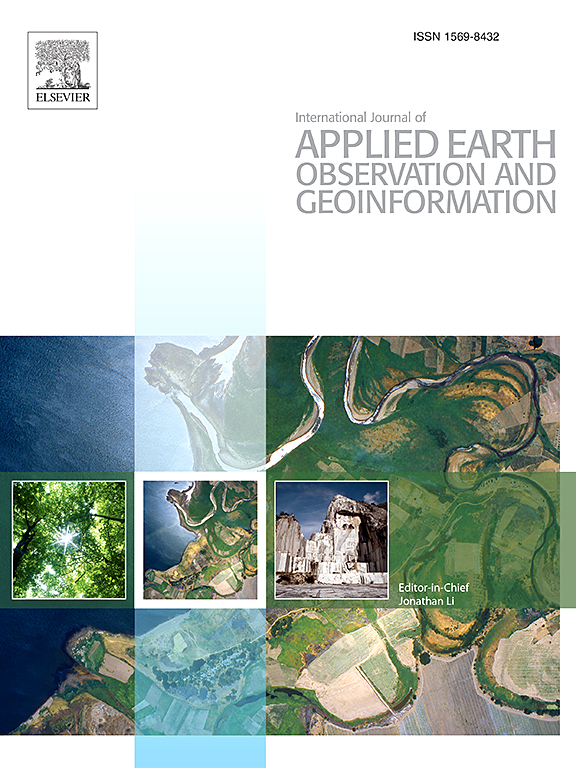Field-scale irrigated winter wheat mapping using a novel cross-region slope length index in 3D canopy hydrothermal and spectral feature space
IF 7.6
Q1 REMOTE SENSING
International journal of applied earth observation and geoinformation : ITC journal
Pub Date : 2025-05-27
DOI:10.1016/j.jag.2025.104628
引用次数: 0
Abstract
Understanding the spatial and temporal distribution of irrigated cropland at the field scale is essential for managing irrigation water use and addressing the water-food nexus. While global and regional irrigation products exist, they often classify irrigated crops based on machine learning principles, where irrigated crops outperform rainfed ones. However, these methods typically lack mechanistic representation and are rarely applicable at the field scale over long time series. Additionally, identifying irrigated cropland in dual-season systems poses challenges due to temporal heterogeneity, leading to potential misclassification. To address these issues, we constructed a 3D canopy feature space including hydrothermal characteristics (1-precipitation/P, 2-actual evapotranspiration/AET) and spectral characteristic (3-NDVI). This approach is based on two mechanisms: the impact of irrigation on water vapor cycling and its role in promoting crop growth. We introduced a novel cross-region Slope Length Index (SLI) to map irrigated and rainfed crops at the field scale. Our method involved downscaling NDVI and AET using spectral fusion techniques (STF) on Google Earth Engine (GEE), followed by fitting a robust rainfed line (AET = −125.41 + 0.84 × P, R2 = 0.70) at the provincial scale, and calculating the SLI. Then A case of irrigation map (Irri_HNP) was generated by a threshold for crop water supply and demand, achieving ≥ 38 % accuracy improvement on overall accuracy (OA = 0.973) compared to existing products. The SLI method also exhibited strong stability when generalized to the national scope (AET = −74.41 + 0.82 × P, R2 = 0.73), maintaining robustness in both drought and humid years (AET = −177.08 + 0.82 × P, R2 = 0.69). The method’s scalability and transferability have been rigorously validated across diverse regions and environments, spanning from provincial to national scales. This validation achieved an OA of 0.922, demonstrating robust performance under heterogeneous conditions. Furthermore, the framework provides actionable insights for field-scale crop management and agricultural water governance.
基于三维冠层热液和光谱特征空间的新型跨区域坡长指数的大田灌溉冬小麦制图
了解农田尺度上灌溉农田的时空分布对于管理灌溉用水和解决水-粮食关系至关重要。虽然存在全球和区域灌溉产品,但它们通常基于机器学习原理对灌溉作物进行分类,其中灌溉作物的表现优于雨播作物。然而,这些方法通常缺乏机械表征,很少适用于长时间序列的现场尺度。此外,由于时间异质性,确定双季系统中的灌溉农田存在挑战,导致潜在的错误分类。为了解决这些问题,我们构建了包含热液特征(1-降水量/P, 2-实际蒸散发/AET)和光谱特征(3-NDVI)的三维冠层特征空间。该方法基于两种机制:灌溉对水汽循环的影响及其对作物生长的促进作用。我们引入了一种新的跨区域坡长指数(SLI)来在田间尺度上绘制灌溉和雨养作物。我们的方法是在谷歌Earth Engine (GEE)上使用光谱融合技术(STF)降尺度NDVI和AET,然后在省级尺度拟合稳健雨育线(AET = - 125.41 + 0.84 × P, R2 = 0.70),并计算SLI。利用作物需水量阈值生成灌溉图案例(Irri_HNP),总体精度较现有产品提高≥38% (OA = 0.973)。SLI方法在全国范围内也表现出较强的稳定性(AET = - 74.41 + 0.82 × P, R2 = 0.73),在干旱和潮湿年份均保持稳稳性(AET = - 177.08 + 0.82 × P, R2 = 0.69)。该方法的可扩展性和可移植性已经在不同地区和环境中得到了严格的验证,从省级到全国范围。该验证的OA为0.922,在异构条件下表现出稳健的性能。此外,该框架还为农田规模的作物管理和农业用水治理提供了可操作的见解。
本文章由计算机程序翻译,如有差异,请以英文原文为准。
求助全文
约1分钟内获得全文
求助全文
来源期刊

International journal of applied earth observation and geoinformation : ITC journal
Global and Planetary Change, Management, Monitoring, Policy and Law, Earth-Surface Processes, Computers in Earth Sciences
CiteScore
12.00
自引率
0.00%
发文量
0
审稿时长
77 days
期刊介绍:
The International Journal of Applied Earth Observation and Geoinformation publishes original papers that utilize earth observation data for natural resource and environmental inventory and management. These data primarily originate from remote sensing platforms, including satellites and aircraft, supplemented by surface and subsurface measurements. Addressing natural resources such as forests, agricultural land, soils, and water, as well as environmental concerns like biodiversity, land degradation, and hazards, the journal explores conceptual and data-driven approaches. It covers geoinformation themes like capturing, databasing, visualization, interpretation, data quality, and spatial uncertainty.
 求助内容:
求助内容: 应助结果提醒方式:
应助结果提醒方式:


